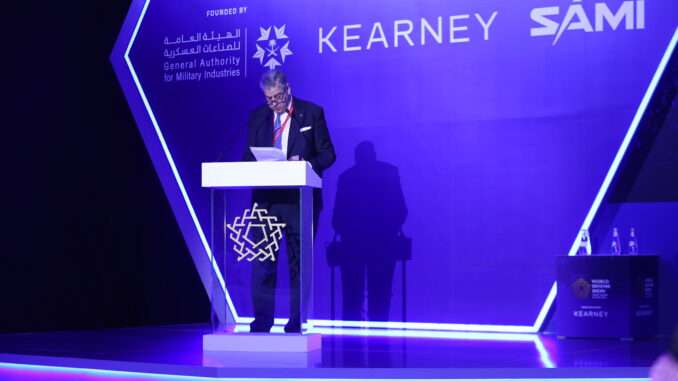
The maritime domain remains unrivalled in scope and importance, and managing it is key to maintaining control of major critical infrastructures and trade routes. In his recent address to the World Defense Show 2024, Ambassador Stefano Pontecorvo, Chairman Leonardo, outlined the potential risks and areas of innovation needed to protect national security and the global economy.
The maritime domain is a complex and complicated environment. It includes activity on the surface of open water, closed bodies of water and navigable waterways, and also below the surface, to depths that are often unknown and unfathomable. It includes every type of human-built object, above or under water, static or moving, but must also consider the safeguarding of all the salt and freshwater creatures sharing the same domain.
When addressing industry and constitutional leaders at the recent World Defense Show, Ambassador Stefano Pontecorvo, Chairman Leonardo, observed that it is probably the least known and most complicated global domain, perhaps even more so than outer space. However, it is a realm that is constantly evolving, and has been the focus of intense technological development in recent years, with a growing number of critical infrastructures bound to or hosted by the domain.
He explained: “Underwater pipelines and cables are core features of the industrialized world: over 550 submarine cables carry 97% of global internet traffic; over 30,000km of seabed pipeline carry oil and gas from offshore drilling platforms, and across countries. While these two infrastructures have been a major concern in the recent years, particularly with some significant disruptive events taking place in the Baltic, many more infrastructures are bound to global waters, such as desalination plants, ports, power plants – from thermal to wind based – and all rigs used to extract resources from the seabed.
“But obviously, the maritime domain is also a huge waterway, probably the major enabler of the global economy, allowing the shipment around the world of 80% of the goods that are traded worldwide and a tireless fleet of over 100,000 ships that transport raw materials components, semi-manufactured goods and final products to be delivered to businesses and consumers.”
That the maritime domain is a major enabler of the global supply chains, is also what makes it a potential source of major turbulence, such as the port congestion witnessed in the aftermath of the Covid pandemic, disrupting global deliveries. The ongoing Ukrainian crisis is currently impacting shipments, with companies having to reroute cargos away from the Black Sea. In the Middle East, unpredictable activity in the Red Sea has caused some of the major shipping companies to reroute cargo around Africa and the Cape of Good Hope, regardless of the accompanying increase in time, cost and pollution.
Pontecorvo spoke of the many platforms and solutions Leonardo offers, based on the company’s multi domain experience and system of systems integration capability, all required to work together to build maritime domain awareness, and to build productive knowledge of all the elements and actions that could impact security, safety, economic activity and the environment.
He said: “Even speaking of being aware of what happens in such a heterogeneous domain is a pretty daunting proposition. We are constantly innovating in terms of sensors, of data fusion, of analytics, but also of data interpretation and presentation models, because technology is simply not enough.
“Sailors, coastal operators, offshore workers, air support staff, and economic and institutional stakeholders are human beings that need to have the most complete and direct information to support the decisions to direct or carry out maritime operations. As usual, better information is as usual the driver of competitiveness and superiority.
“For this very reason one of the areas of faster and stronger innovation for us has always been command and control. That is precisely the peak of the information collection and generation process, where data from multiple actors converge and decisions are taken, often by multiple stakeholders, making the process delicate, complex and time sensitive,” he added.
As one of the major applications in the domain awareness montage, command and control remains a major focus for innovation. The application needs to collect, collate and integrate information from all available sources – from surface and underwater vessels, as well as surveillance systems on the coast, on vessels, on the seabed, on aircraft and on satellites.
To do this requires secure communication channels, tailored to source-specific conditions. This ranges from line of sight to over the horizon, from close range laser channels to underwater long waves. This data is then collected and processed, to predict volumes, timings, and expected outcomes.
The only way to gain competitiveness advantage and authority in the maritime domain is through improved communication, and the defense industry is seeing a wave of logical and operational innovation from major players, designed to drive this change and achieve information superiority.
Pontecorvo said: “Leonardo is working in its labs and its divisions on technological developments and innovations for its products, systems and platforms bound to the maritime domain. We continue to improve sensors and payloads. We apply deep digitalization, offering better modelling and interpretation of data through high performance computing platforms, artificial intelligence and digital twins, not only of products but of complex systems.”
The company aims to enhance command and control by better integrating and distributing uniform information with a comprehensive multi-domain approach, leveraging all domains and empowering maritime operations through better awareness.
Pontecorvo summarized: “The maritime domain scope is so wide that its stakeholders group is as wide and diverse as one could imagine. A coordinated approach from all involved actors is mandatory to manage the domain effectively, and coordination can be achieved only through innovative solutions.”



Be the first to comment